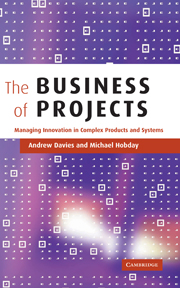Book contents
- Frontmatter
- Contents
- List of figures
- List of tables
- Foreword
- Acknowledgements
- Glossary
- 1 Introduction
- 2 The dynamics of innovation in complex products and systems
- 3 Business strategy and project capability
- 4 Systems integration and competitive advantage
- 5 The project-based organisation
- 6 Managing software-intensive projects
- 7 Learning in the project business
- 8 Integrated solutions for customers
- 9 Lessons for the project business
- Appendix A
- Appendix B
- Appendix C
- References
- Index
Appendix C
Published online by Cambridge University Press: 22 September 2009
- Frontmatter
- Contents
- List of figures
- List of tables
- Foreword
- Acknowledgements
- Glossary
- 1 Introduction
- 2 The dynamics of innovation in complex products and systems
- 3 Business strategy and project capability
- 4 Systems integration and competitive advantage
- 5 The project-based organisation
- 6 Managing software-intensive projects
- 7 Learning in the project business
- 8 Integrated solutions for customers
- 9 Lessons for the project business
- Appendix A
- Appendix B
- Appendix C
- References
- Index
Summary
Research leading to the project capability building model
The PCB model presented in Chapter 7 was a product of inductive research (Eisenhardt, 1989: 535) based on the empirical findings of three successive research projects undertaken between 1994 and 2003. As shown in Table C.1, Project 1 identified Ericsson's move into a new category of projects. It proposed the hypothesis that Ericsson's new ‘turnkey project’ represented a generic move taking place across industries. But there was little evidence to support this claim until Project 2 which found that Cable & Wireless was also moving into the provision of a new category of projects which Project 3 referred to as ‘integrated solutions’. It was not until Project 3 that in-depth case study evidence was collected to confirm that five firms operating in different industries were developing the capabilities to move into the provision of integrated solutions projects.
The process of theory building was highly iterative and the long gestation period for the emergence of the theory reflects the empirical evidence. It has taken a long time for the organisations to build capability and to overcome organisational inertia as they move from a focus on exploring new possibilities to full exploitation of a new line of projects. Throughout the three research projects, data were collected in a variety of ways. The authors conducted 126 data-gathering interviews (lasting around two hours each) with strategic managers (including current and former CEOs), senior project managers, heads of functional departments and managers involved in project and line activities.
- Type
- Chapter
- Information
- The Business of ProjectsManaging Innovation in Complex Products and Systems, pp. 277 - 279Publisher: Cambridge University PressPrint publication year: 2005



